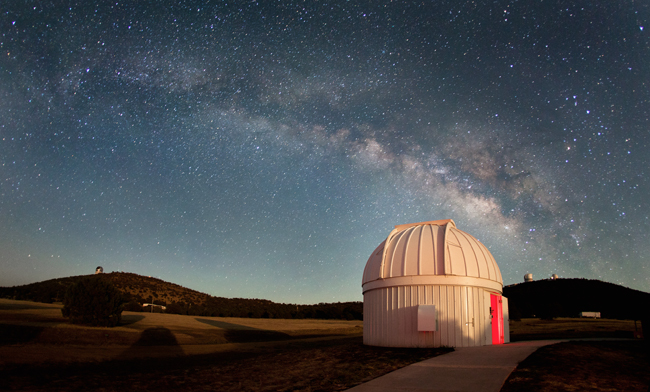The University’s McDonald Observatory rests in a seven-county light ordinance zone, deep in the Davis Mountains of West Texas, protecting it from the light pollution that plagues most cities and making for some of the darkest skies in the country.
Founded in the 1930s, the observatory is one of the leading centers for astronomical research, education and outreach, boasting more than six advanced telescopes.
Bill Wren, a spokesman for the observatory, said on any given night you can see thousands of stars there.
“The places you can go to see a naturally dark sky are vanishing,” Wren said. “We are raising people that have never seen a naturally dark sky.”
Wren said this is because light pollution, created when light is shone upward into the sky, interferes with our ability to see clearly.
Irresponsible lighting wastes energy and costs Americans an estimated $2.2 billion a year, according to the International Dark-Sky Association. The initiative was launched in 2010 to raise awareness about the effects of light pollution.
“This is not an anti-light campaign,” Wren said. “It’s about putting the light where it’s needed.”
Light ordinances encourage shielding light, aiming it downward and using solar-powered, LED lights when possible.
The biggest threat to dark skies at the observatory is the growing oil and natural gas industry in the Permian Basin region, Wren said. According to the Railroad Commission of Texas, more than 9,000 drilling permits were issued in the Permian Basin in 2012 alone.
“In the spectrum of environmental concerns, light pollution is probably low on the list for oil and natural gas companies,” said Colt McCarthy, who owns a drilling supply company. “People don’t really pay attention until it affects their pocketbooks.”
Chevron spokeswoman Dolores Vick said McDonald approached the energy company earlier this year to discuss its lighting practices near the observatory.
“We are researching current lighting practices used in our West Texas operations to determine if there are ways to safely reduce light that emanates from our operations,” Vick said.
In Austin, more than 400 miles away from the observatory, the city set aside $15 million in 2012 to replace the bulbs and fixtures on approximately 70,000 street lamps to combat light pollution in Central Texas.
By 2015, Austin Energy anticipates all the city’s street lamps will be automated, with LED bulbs and flat-glass lenses that focus light downward instead of scattering it toward the sky. The “smart street lights” will conserve energy, as well as reduce light pollution.
“We are one of the few cities in the country that are both automating their street lights and making them dark sky compliant,” Austin Energy spokesman Carlos Cordova said.
With the observatory more than a six-hour drive away, Wren said the best place to see a dark sky in the Austin area is at Austin-Bergstrom International Airport. Wren said pilots are particularly opposed to bright lights and use shielded lighting to safely depart and land planes.
The astronomy department also hosts Wednesday night public viewings with its telescope on the roof of Robert Lee Moore Hall, as well as Friday and Saturday night viewings at Painter Hall.





















